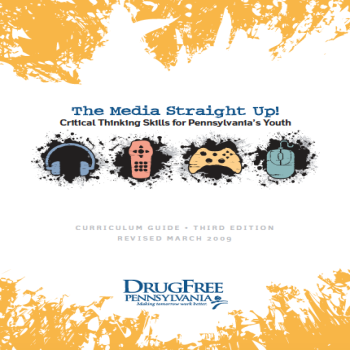
Engage learners in exploring substance abuse prevention using the pedagogy of media literacy
THE MEDIA LITERACY GUIDE
Created by Renee Hobbs and the Media Education Lab and co-sponsored by Drug Free Pennsylvania. Download the whole curriculum as a PDF here
Renee Hobbs and a team of Pennsylvania educators developed The Media Straight Up to bring together literacy and substance abuse prevention goals for middle-school students. The curriculum meets PA standards for health and English language arts.
According to the Office of National Drug Control Policy, a media literacy approach can support substance abuse prevention goals. Media literacy can empower youth to be positive forces of social change, which benefits drug prevention efforts by teaching youth:
-
To recognize how media messages influence them. Students can internalize the skills they need to protect themselves against messages about drugs or unhealthy lifestyle choices.
-
To develop critical thinking. When youth learn to analyze media, they can uncover the values messages about drugs embedded in media and decide whether to accept or reject those messages.
-
To foster healthy self-esteem. Students skilled and knowledgeable about the media and their techniques can use media to creatively produce messages of their own. Encouraging healthy self-esteem is one of the “anti-drugs” that reduce children’s vulnerability to drug use.
ACTIVITIES FOR A PROFESSIONAL DEVELOPMENT TRAINING:
1. Lesson Plan 2: Positive and Negative Messages in the Media. Interview your partner to discover what are some of the positive messages that are presented in your favorite TV shows? What are some of the negative messages that are presented in your favorite shows? As you interview your partner, put your key ideas on the Titanpad here.
2. Lesson Plan 6: Music, Media and Drug Abuse. First we read and discuss Brad Paisley's "Alcohol" to learn how to use critical questions. Then, working in your group, read your team's selected music lyrics and watch the music video. Then discuss the questions on page 38 with your team.
TEAM 1: Kid Cudi, "Day N Nite"
TEAM 2: Amy Winehouse, "Rehab"
TEAM 3: Bruno Mars, "Liquor Store Blues"
3. Lesson Plan 7: Media Role Models (p. 47) Using your own knowledge and information you find online, make a chart showing three examples of celebrities who have made the news for their positive or negative decisions? When you are done, use the Flipgrid to summarize and reflect on 1 - 2 celebrities who have gotten attention for their positive or negative behavior. Conclude by explaining how talking about the ethical and moral issues related to celebrities can develop critical thinking skills. Click here to access Flipgrid.
4. Lesson Plan 8A: Four Big Myths of Prescription and OTC Drug Use (p. 52).
GROUP A. Watch this video about the misuse of prescription drugs.
GROUP B. Watch this short video about addiction to prescription drugs.
ACTIVITY: Read and discuss then search online for three stories about prescription drug use in different types of media. Use the Titanpad to put your three online sources here and comment on and analyze what you learned.
5. Lesson Plan 10. Talking Back to the Media. Create a screencast where you summarize that you learned.
6. Lesson Plan 11. Preparing to Make a Public Service Announcement. ACTIVITY: After reading and discussing the article on page 67, view this PSA and identify the target audience, the author's purpose, and the persuasive techniques using the Media Literacy Smartphone.
TWITTER 101 FOR PREVENTION EDUCATORS
A short video overview from media literacy educator Julie Smith
Explore some hashtags: #redribbonweek | #drugfreelife | #freedomfrom addiction | #addiction